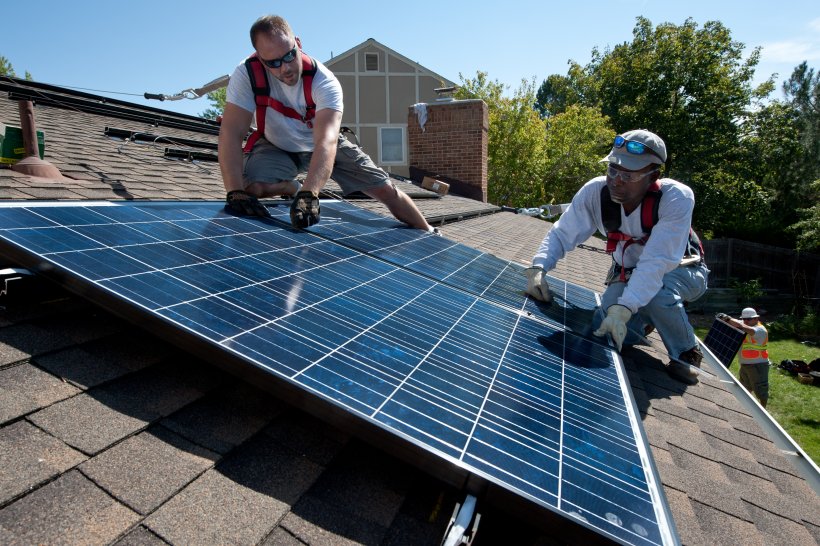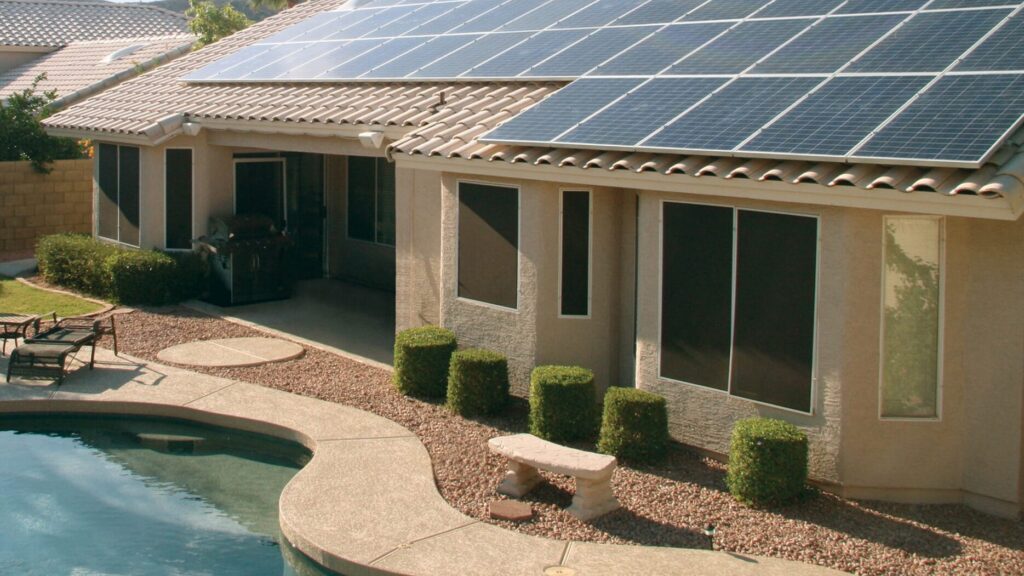What You Need to Know About the California Solar Tax Credit in 2025…
As 2025 begins, California continues to lead the way in green energy initiatives, offering some of the most attractive solar tax incentives in the country! These incentives reflect the state’s commitment to renewable energy and present a golden opportunity for homeowners and businesses alike to make a smart, eco-friendly investment.
But what exactly are the California solar incentives for 2025? Let’s talk about it! From understanding the basics of solar tax credits to navigating the newest state-specific incentives, we’ll illuminate everything you need to know to make an informed decision and potentially save big on your energy bills.
Let’s harness the power of the sun and explore how these California solar incentives can brighten your financial future!
Federal Solar Incentives

Federal Solar Tax Credit
The first solar tax incentive for Californians is the federal solar tax credit. This credit lets you deduct a portion of your solar energy installation cost from your taxes, making it easier for homeowners to go solar.
Until last year, the solar tax credit was capped at a rate of 26% and was set to expire in 2024. Then, Congress passed the Inflation Reduction Act of 2022, extending the solar tax credit program until 2035.
This means that if you install solar panels on your home any time between January 24, 2022, and December 31, 2035, you are likely eligible for a significant credit on your annual federal income tax.
However, while these incentives are here to stay, the cost of electricity is rising every year. In California, energy costs may increase by as much as 56% since 2020. The sooner homeowners make the switch to solar, the sooner they can protect themselves from these rapidly growing costs of traditional energy sources.
Solar Tax Credit Rate
In addition to extending the solar tax credit program, the Inflation Reduction Act of 2022 also raised the credit rate to 30% of solar installation costs until 2032. Starting in 2032, that rate will decrease until it phases out entirely in 2035.
Federal Solar Tax Credit Rates for each Year
| 2022-2032 | 30% |
| 2033 | 26% |
| 2034 | 22% |
| 2035+ | 0% |
Note: The solar tax credit applies to the total cost of your solar energy system—including both labor and equipment!

Federal Solar Tax Credit Eligibility
To claim the solar tax credit, all of the following must be true:
- The solar energy system must be installed and operational during the tax year for which you’re claiming the credit.
- You must own the solar energy system (i.e., you have purchased it with cash or through a loan, not leased it or entered into a power purchase agreement).
- The solar energy system must be installed in a home located in the U.S. that you use as a personal residence. (It doesn’t have to be your primary residence, however.)
- You must install new solar panels. The solar tax credit does not apply to used panels.
Claiming the Federal Solar Tax Credit
After installing a solar energy system on your home, you can claim the federal solar tax credit when filing your annual taxes. The Current Home team is well-versed in helping all our customers with this step. We will provide all the necessary documents to prove the cost of your system and claim your credit..
However, because the solar tax credit is non-refundable, you won’t receive a refund or rebate if you don’t owe taxes. The same is true if your tax credit exceeds your tax debt.
For example, let’s say you can claim a $15,000 solar tax credit while owing $13,000 in taxes. You could use the credit to erase your tax bill.
The good news is that the solar tax credit does roll over, so you could use the remaining $2,000 to lower next year’s tax bill. In fact, you can apply your excess tax credit for up to five years in the future.

How Much Is the Solar Tax Credit for Californians?
The amount of money you can claim through the solar tax credit depends on the cost of installation. Expenses that qualify include:
- Solar panels (for first-time installations)
- Solar inverter, wiring, mounting gear, and solar storage
- Solar batteries
- Inspection
- Installation labor
- Sales tax
To determine your solar tax credit, you can combine all qualifying expenses and multiply by the credit rate for that year. Then, simply deduct that amount from your tax bill. Better yet, let us do it for you! At Current Home, we are always ready to help homeowners calculate their solar tax credit.
There’s no maximum credit amount you can claim, either. No matter how large your investment is, you can receive the full 30% as a credit.
How Many Years Can You Claim the Solar Tax Credit?
You can only claim the solar tax credit for a single year—the year in which you installed your new solar energy system. However, if you have any credit amount left over after applying it to your taxes, you can carry the remainder over to future years. The rollover period is up to five years after the solar system is installed.
The Federal Solar Tax Credit for Californians
For our customers in California, the average cost for a home solar system often ranges from $25,000 to $50,000. This means that at a rate of 30%, the average California homeowner could claim a solar tax credit of anywhere between $7,500 and $15,000. (Of course, that rate will decrease starting in 2032—but there’s still plenty of time to claim your savings if you move fast!)

California Solar Incentives
In addition to the federal solar credit, California homeowners can claim tax benefits at the state level, too. These California solar incentives make it even easier to make the switch to solar power.
Solar System Property Tax Exemption
In an effort to encourage solar energy, California guarantees that the addition of a solar energy system won’t raise your property taxes. The state offers a property tax exclusion for solar energy systems, meaning any increase in home value due to solar panels won’t be included in property tax assessments. (However, this benefit is currently set to expire this year in 2025.)
Self-Generation Incentive Program (SGIP)
California’s Self-Generation Incentive Program (SGIP) offers rebates that can cover a significant portion of the cost of an energy storage system installation. The rebate amount can vary, with a higher incentive provided for systems installed in areas at high fire risk or that have experienced multiple Public Safety Power Shutoff events.
Net Metering
California’s Net Energy Metering (NEM) program allows solar system owners to receive credits for surplus energy they generate. When you connect your solar system to the electric grid, you can “sell” the excess power back to your utility provider.
In the past, this was one of the best California solar incentives available. Unfortunately, the recent changes of NEM 3.0 have removed some of the benefits of net metering. But while the new rules are not as generous for a basic solar energy system, by adding a battery, you can still reduce (or even erase) your utility bill through this program.
Disadvantaged Communities – Single-Family Solar Homes (DAC-SASH) Program
California’s DAC-SASH program provides solar incentives for low-income homeowners in disadvantaged communities. This program is administered by GRID Alternatives and offers up to $3 per watt in incentives. In many cases, this could cover the full cost of installation.
Local California Solar Incentives
Many areas in California provide their own local solar incentive programs, including rebates and discount pricing. For example, the city of San Diego waives building permit fees and plan check fees for the installation of residential solar panels. This is part of the San Diego Green Building Incentive Program.
Solar Company Incentives
Solar installation companies often offer their own incentive programs. For example, at Current Home, we give new customers affordable financing options with $0 down and 12 months of free energy. This lets homeowners reap the benefits of solar power without having to make any upfront investment.

The Future of Solar Energy in California
The future of solar energy in California is as promising as ever. With the state’s commitment to renewable energy, advancements in solar technology and increased affordability are expected. California is likely to see a continued rise in residential and commercial solar installations.
Innovations in solar storage and battery technology will also play a significant role in enhancing the efficiency and reliability of solar systems. Additionally, state policies and solar tax incentives are anticipated to evolve, further encouraging the adoption of solar energy across diverse communities in California. This momentum positions California as a leader in solar power, driving both environmental sustainability and economic growth.
Is Going Solar Worth It In California?
Absolutely! Opting for solar power can be a smart move anywhere in the U.S., but the sunny weather of California makes it especially practical for residents of the Golden State. Here are just a few of the benefits of going solar in California:
Lower Energy Bills
Solar power can drastically reduce or eliminate your electricity bills. Even with the initial investment, the long-term savings are substantial due to California’s high electricity rates and ample sunshine.
Higher Property Value
Solar power can increase your property value significantly. Studies suggest that homes with solar panels sell for a premium compared to non-solar homes, partly due to the appeal of lower energy costs.
Protection Against Rising Energy Costs
Solar power shields you from the volatility of traditional energy prices. With your own solar system, you’re less impacted by future increases in electricity rates.
California Solar Incentives, Credits, and Rebates
The combination of federal tax credits and state-specific incentives like SGIP or DAC-SASH programs makes solar installations more affordable. These incentives lower the upfront cost and speed up your return on investment.
Eco-Friendly Impact
By reducing reliance on fossil fuels, solar energy helps lower greenhouse gas emissions, contributing to a healthier environment. It aligns with California’s ambitious climate goals.
Sustainable Living
Solar energy is a cornerstone of sustainable living. It aligns with California’s progressive environmental policies and the growing societal shift towards eco-friendly practices.
Energy Independence
Solar panels can provide a degree of independence from traditional energy sources, reducing vulnerability to energy price volatility and potential grid outages.
Reliability
Modern solar systems are durable and require minimal maintenance, ensuring long-term reliability and performance with little additional cost.
Economic Growth
The solar industry in California creates jobs and supports local businesses, contributing to economic growth.
In conclusion, opting for solar energy in California is not just an environmentally conscious decision—it’s a financially smart one too! The state’s policies, combined with its natural resources, create the ideal environment for going solar.
Installing Solar Panels in California: The Process
Once you’re ready to embark on a solar journey in California, here are the standard steps involved:
1. Find a Suitable Solar Provider
California has plenty of experienced, certified solar installers ready to help you make the switch. Check reviews and references, and find a provider with a reputation for success. At Current Home, we have years of experience assisting California homeowners in making the right decisions for their homes.
2. Get a Free Solar Assessment and Quote
A reputable solar installer will discuss your energy needs with you and make an appointment to review your property. They can determine if your home is suitable for solar energy based on location, sun exposure, roof condition, and energy usage. Then, they can give you a custom design and detailed quote for the installation process.
At Current Home, this process is always free! Get your free solar quote today.
3. Discuss Financing Options and California Solar Incentives
Talk to your solar provider about various financing options, including solar loans, leases, and sustainable energy programs. They will likely be able to point out the federal incentives, California solar tax credits, and local incentives available for you.
4. Get the Right Permits
The permits and licensing required to install solar panels varies from place to place. Your installer will be familiar with this process and can handle the paperwork for you. That way, you can rest easy knowing you’re in full compliance with California state and local laws.
5. Install Your Brand New Solar Panel Energy System
Your solar provider will install your custom-designed solar system. Professional installation can take from a few days to a week, depending on the system’s complexity.
At Current Home, we handle every step of this process ourselves with NO outsourcing. From inspections to roof repairs to installation, we are your one-stop shop for all things solar. This is how Current Home is able to offer the fastest installation times in Southern California.
We pride ourselves in completing every project as efficiently as possible—while still maintaining the ultimate standards for safety.
6. Connect to the Grid
After installation, a local government inspection is required. The Current Home team will schedule these inspections for you so you can skip the headaches.
Once this step is done, your system will be connected to the grid and you can begin using solar power to reduce your monthly energy bills.
7. Get to Know Your System
To get the most out of a solar system, you’ll want to know how to maintain and protect it. Your solar provider should give you a clear understanding of your warranties, service policies, and who to contact for support to ensure that your system operates as efficiently as possible in the years to come.
8. Enjoy Your Energy Independence!
Congratulations! You are now the proud owner of a fully functioning solar power system. Enjoy the lower energy costs, easy upkeep, and greater independence you’ve earned.
Ready to Go Solar?
There’s never been a better time than now to go solar. If you live in Florida or California and are looking to install a home solar system, we can help you get the most out of your investment.
Get your free price quote today!
California Solar FAQs
What are the benefits of going solar in California?
Solar energy has a wide variety of benefits for California homeowners, including:
- Reduced electricity bills
- Increased home value
- Reduced carbon footprint
- Various tax incentives
How do solar tax incentives work?
Solar tax incentives help lower the initial cost of solar systems through tax credits, discounts, and rebates, making solar more affordable for everyone.
What is the California solar tax credit?
California doesn’t have a specific state solar tax credit, but all residents can benefit from the federal solar tax credit—which currently reduces the cost of solar installation by 30%.
Do solar panels increase property taxes in California?
No, solar panels are excluded when valuing a house for state taxes in California. (This tax incentive is currently set to expire in 2025.)
Can I get solar panels for free in California?
While it is typically not possible to install solar panels for free, the various California solar incentives available can drastically reduce the costs. This is especially true for low-income households.
Is net metering worth it in California?
Despite recent changes, net metering can still offer financial benefits by providing credits for surplus solar energy sent back to the grid. However, California’s net metering program is not nearly as valuable as it was before NEM 3.0 policies were adopted.
What is the SGIP and who can benefit from it?
The Self-Generation Incentive Program offers rebates for installing energy storage systems, especially in areas that are high-risk for fires.
Is PACE financing a good option for solar installations?
PACE financing allows homeowners to finance solar installations through their property tax bill, with the loan tied to the property. Unfortunately, this program has not proven to be beneficial for Californians. Most homeowners who opt for PACE end up with a heavy lien on their house, which can greatly reduce the value of their property. For this reason, Current Home does not offer PACE financing.
Are there incentives for low-income households in California?
Yes, programs like DAC-SASH offer incentives for solar installations in disadvantaged communities.
How can I get started with Current Home Solar?
If you’re ready to take advantage of the benefits of solar, we’re ready to help! Just reach out, and we’ll be happy to give you a free quote for all your solar needs.





